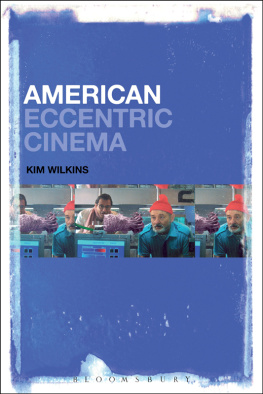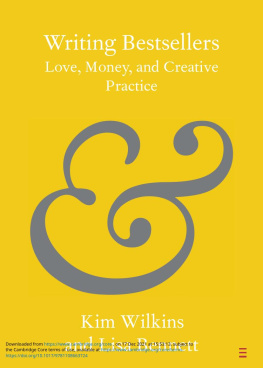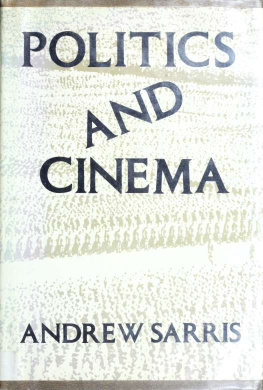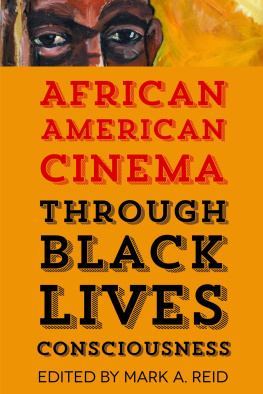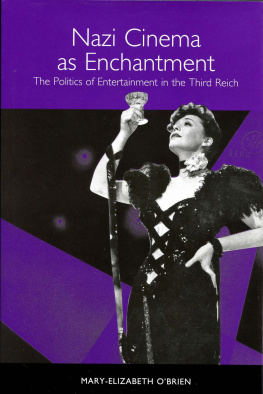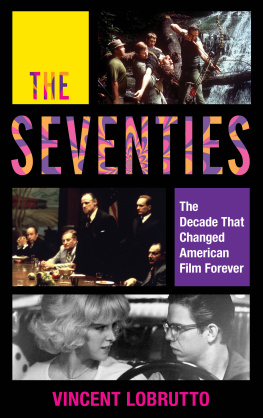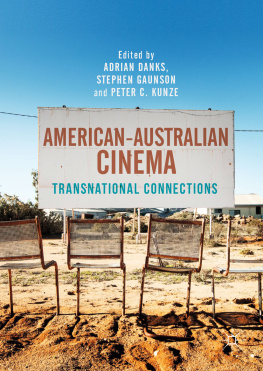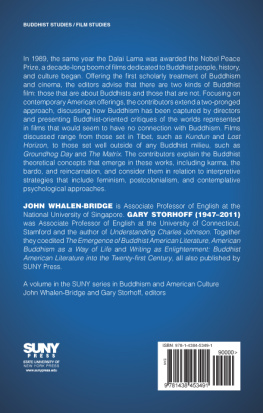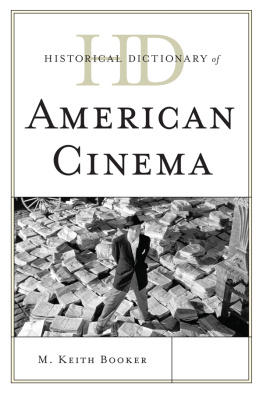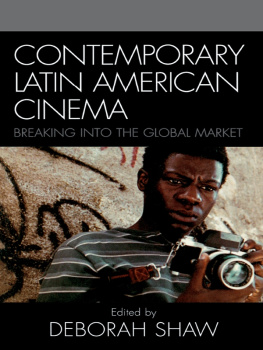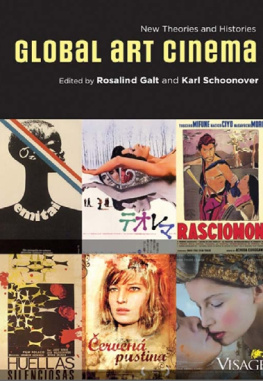American
Eccentric Cinema
American
Eccentric Cinema
KIM WILKINS

BLOOMSBURY ACADEMIC
Bloomsbury Publishing Inc
1385 Broadway, New York, NY 10018, USA
50 Bedford Square, London, WC1B 3DP, UK
BLOOMSBURY, BLOOMSBURY ACADEMIC and the Diana logo are trademarks of Bloomsbury Publishing Plc
First published in the United States of America 2019
Copyright Kim Wilkins, 2019
For legal purposes the Acknowledgments on p. vii constitute an extension of this copyright page.
Cover design: Eleanor Rose
Cover image: Film, The Life Aquatic (2004) Touchstone Pictures/Courtesy Everett Collection / Mary Evans
All rights reserved. No part of this publication may be reproduced or transmitted in any form or by any means, electronic or mechanical, including photocopying, recording, or any information storage or retrieval system, without prior permission in writing from the publishers.
Bloomsbury Publishing Inc does not have any control over, or responsibility for, any third-party websites referred to or in this book. All internet addresses given in this book were correct at the time of going to press. The author and publisher regret any inconvenience caused if addresses have changed or sites have ceased to exist, but can accept no responsibility for any such changes.
A catalog record for this book is available from the Library of Congress.
ISBN: HB: 978-1-5013-3691-1
ePDF: 978-1-5013-3693-5
eBook: 978-1-5013-3692-8
Typeset by Integra Software Services Pvt. Ltd.
To find out more about our authors and books visit www.bloomsbury.com and sign up for our newsletters.
R esearching and writing this book has been a privilege and pleasure thanks to a number of inspirational people who offered their expertise and, most selflessly, their time. I have been incredibly fortunate to have the support of both David Kelly and Bruce Isaacs over a number of years as this project developed. I am forever grateful for their generosity and advice. Special thanks to Bruce for his suggestions on drafts, patience in sometimes rambling conversations, and ongoing enthusiasm for my work. Thanks to Wyatt Moss-Wellington and Peter Marks for their valuable insightsin both writing and conversationand, most importantly, for their friendship. I also wish to thank Claire Perkins, Warren Buckland, and Timothy Corrigan for their feedback on my work at various stages, and to Katie Gallof and Erin Duffy at Bloomsbury for their kind assistance and good humor.
I wish to thank my family. Without their love, trust, encouragement, and interest in my work, this project would never have eventuated. Last, I wish to thank my husband, Ketan Joshi, who indulged every idea I had and read every word I wrote with an analyticaland sensitiveeye. His dedication to my work has greatly enriched this project. There is no way I can ever thank Ketan enough for his enduring support and love, so Ill leave it at that.
I n Charlie Kaufmans stop-motion film Anomalisa (2015), Michael Stone, a famous customer-service guru, is on a lecture tour promoting his book How May I Help You Help Them? Michaels book, in line with contemporary customer service rhetoric, emphasizes the importance of acknowledging the individuality of consumers. However, Michael is not a charismatic and enthusiastic performer; instead he is a motivational speaker who lacks motivation. Anomalisa depicts Michaels malaise over the course of one unhappy night leading up to a lecture at the Fregoli Hotel in Cincinnati. The film opens with a black screen while multiple unrelated conversations are delivered by the same masculine mid-Western voice (Tom Noonan). The dialogue increasingly overlaps until it becomes an overwhelmingly uniform cacophony of words and laughter. It is not until the first shot of Michael that the films ironic conceit is revealed.
Michael is experiencing a form of Fregoli delusion (alluded to in the hotels name). He has lost the ability to differentiate between people. However, rather than believing (as sufferers of the rare Fregoli syndrome do) that one person is donning disguises to play the role of many, Michaels condition is of an existential nature. He is experiencing a crisis of self. Michael yearns for meaningful human connectionbut how can these connections be forged when he sees individuality as an illusion?
Michaels existential crisis is clearly articulated in the delivery of his lecture. The juxtaposition between Michaels advocacy of meaningful customer interactions and his downtrodden tone creates a fissure between content and articulation. His quivering voice reveals despondence, not as a cynical approach to his vocation, but rather with the nature of human existence per se. Michael states: Each person has had a childhood. Each has a body. Each body has aches. What is it to be human? What is it to ache? What is it to be alive? I dont know.
Anomalisa is an example of a mode of American filmmaking that emerged in the late 1990s, which I call American eccentricity. This mode combines formal and stylistic deviations from mainstream cinema conventions through irregularities in characterization, tone, and established generic conventions with a thematic focus on existential crises. Fundamentally, these anxieties express the angst and despair experienced in relation to ones being in the world in the face of personal authenticity, purpose, responsibility, and freedom. With their focus on existential concerns these contemporary films take the cultural and ideological imprints of many films of the New Hollywood era, such as Bonnie and Clyde (1967), The Graduate (1967), and Easy Rider (1969), that demonstrated an American cultural uneasiness and disconnection from their contemporary society, in light of the Vietnam War and the questioning of institutional authority. Yet, as seen in Anomalisa, existential anxiety in American eccentric films does not appear bound to historical specificity. Michael Stone doesnt know why he is disconnected from other humans. His malaise has no nucleus.
Both the American eccentric and New Hollywood films under consideration in this book are thematically and narratively centered on existential anxiety and the yearning for human connection. In this sense, Michaels despair at his inability to understand and connect with others in Anomalisa is similar to Benjamin Braddocks experience in The Graduate. In that film, Benjamin experiences severe isolation and alienationlike much of the youth of the 1960s, the source of his anxiety is his fraught position in contemporary American society. For Benjamin, this anxiety stems from a particularly privileged position. His personal concerns are not impacted by issues of race or gender, nor are they bound to immediate economic uncertainty. Rather, Benjamin is at odds with the materialistic and conservative ideology of his parents generation.
However, with the Berkeley University clashes of 19641965 over, and the social codes of his own generation unanchored, for him the generational conflict has become an uncomfortable bedfellowboth ideologically and literally through his taboo intimacy with one of the older generations more complex and conflicted members, Mrs. Robinson. Thus, Benjamin is a figure that reflected a zeitgeist concerned with existential and cultural interrogation from a specifically male, and white, perspective. He, like many New Hollywood characters, can be read as an embodiment of this perspective, and its relationship to a pervading generational sense of inconsequence and futility in regard to ambition, motivation, and the pursuit of the American Dream. American eccentricity shares this form of existential anxiety as a thematic drive with these New Hollywood films. However, American eccentric cinema does not depict existential anxiety as located in external sites of cultural and national unrest. Instead, American eccentric films present existential anxiety as individual crises distinct to idiosyncratic characters rather than shared concerns that manifest in relation to historical contexts. In
Next page
